Chaparral Motorsports 25" ATV Tire Shootout Challenges Explained

As one of the largest powersports retailers in the country,
Chaparral Motorsports sells thousands of ATV tires a year. And with
those sales often come a lot of questions from the purchaser, the
one question we get asked most often though is "what is the best
ATV tire?" That's really a tough question to answer because it
depends on several factors such as the type of terrain you
typically ride, what you are looking for when you want "the best
tire" and what features are important to you in regards to how well
a tire performs i.e. can it stop fast, does is climb well, can it
handle mud?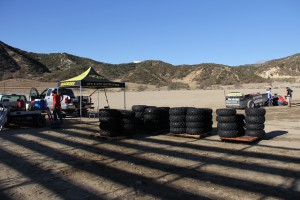
In order to answer the question "what's the best ATV tire" we have
to ask the customer several questions in return before we can
suggest some tire options that will suit their wants and desires.
Over time we've learned that not ATV riders are looking for the
same thing in a tire. So we decided to do some testing with a bunch
of ATV tires to show how each tire performs at specific tasks and
created the Chaparral Motorsports 25" ATV Tire Shootout.
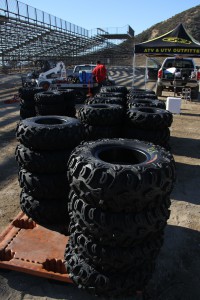
The purpose of the shootout was to pit 21 of the most popular ATV
tires we sell head-to-head in a variety of challenges to see which
tires performed best in each setting. The vehicle we used was a
2017
Yamaha Kodiak 700. We captured each tire test with a mix of
video and still photography so that we could then thoroughly
document and show viewers how each tire performed during testing.
The five tests we came up with for the shootout were designed to
mimic real world scenarios that riders would typically experience.
They are as follows:
Sled Pull
Just like the tractor pull competitions you might have seen on TV,
this test was designed to see how much weight the ATV tires could
handle in a pulling type scenario before breaking loose and just
digging into the ground without making any more forward momentum.
It turns out the sleds used in sled pull competitions are rather
pricey, therefore we utilized some ingenuity and materials we had
around the Chaparral facility to build our own sled. We used and
watercraft testing tank and the main component, added a skid to the
bottom front and an axle to the rear.
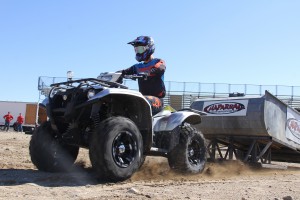
On top of the tank we rigged up a sliding rack weighted with sand
bags and 5 gallon utility jugs filled with water. The rack was
connected to winch mounted to the front of the tank. Once switched
on, the winch would pull the weight forward thus continually
increasing the weight on the skid as the rack moved closer to the
front of the tank. The entire contraption weighed more than
3,000lbs. With the rack at the rear of the sled the weight at the
skid was about 380lbs. As the rack climbed up the tank the weight
increased to 500lbs after 4 seconds of run time, 900 lbs after 9
seconds, and then maxed out our scale at more than 1,000lbs after
12 seconds of run time. The tires were judged on how far they could
pull and at what time/weight they stopped gaining forward
momentum.
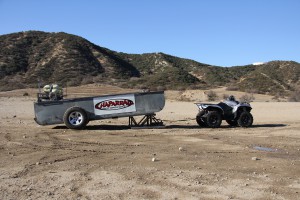
Hill Climb
This test was performed on a rather steep incline that is part of
the REM course at Glen Helen Raceway. Aside from being a steep
grade, the dirt was quite soft and loamy.
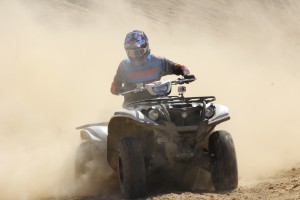
The rider started at the base of the hill and a soon as the timer
gave the ok signal the rider would pin the throttle and head
straight up the hill. The climb was approximately 245 feet from the
base to the top. The tires were judged on how long it took them to
crest the top of the hill. Not all the tires were successful in
this test.
Downhill Braking
In this test, the rider started at the top of the hill climb and
then coasted down 100 feet before slamming on both the front and
rear brakes. The tires were judged on how long it took the quad to
come to a complete stop once the brakes were applied.
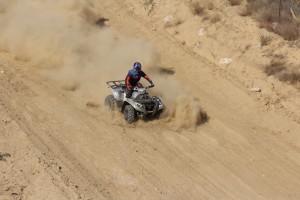
Top Speed Braking
In this test the rider gunned the ATV at full speed for
1/8th of a mile and then applied the front and rear
brakes. As soon as the rider crossed the braking line the stop
watch was started and then stopped once the vehicle came to a
complete stop.
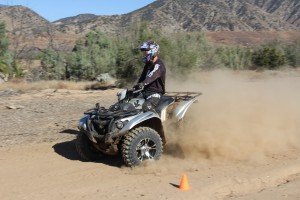
Mud Traction Test
This test was a challenge for us in the fact that it rarely rains
in Southern California, so finding a good mud pit we could test
tires in was rather difficult. We ended up creating our own 95-foot
long mud bog with the help of a backhoe and lots and lots of water.
We ended up with a very nice mud pit that was just wider than the
Kodiak and had some great mud that was about 2 feet deep.
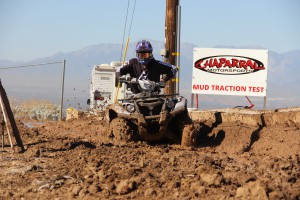
You can check out the video below and watch how each test was
performed. In the next few days we will be uploading a results
article and video to our YouTube page highlighting the
Top 8 Best Overall Performing Tires in the shootout and
then we will follow that up with an article and video which will
break down each test and showcase
The Best Tires for Specific Tasks.
